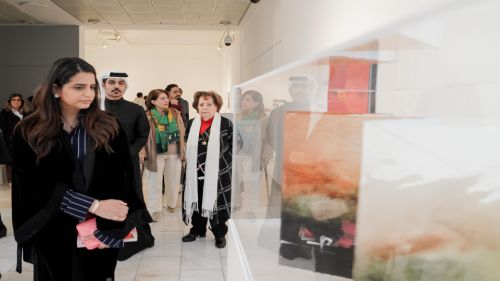Contact Center
.
16 February 2025
As Part of the 19th Spring of Culture Festival, The Artist Books Exhibition by the Late Iraqi Artist Rafa Al Nasiri Opens at the Bahrain National Museum


The Bahrain National Museum inaugurated the Artist Books exhibition by the late Iraqi artist Rafa Al Nasiri today, in the presence of Her Excellency Shaikha Dwa bint Khalid bin Abdullah Al Khalifa, member of the National Council for Arts, alongside officials from the Bahrain Authority for Culture and Antiquities, prominent figures in the art scene, and cultural enthusiasts in the Kingdom of Bahrain.
Part of the 19th Spring of Culture Festival, the exhibition is held in collaboration with Art Concept Gallery and will remain open to visitors until 16 May 2025, from 9 AM to 8 PM, closed on Tuesdays.
Rafa Al Nasiri's works weave together Arabic calligraphy, poetry, and abstract expression, transcending the traditional boundaries of text and image. His art serves as both a form of cultural preservation and a reflection on identity, particularly in the context of the social and political challenges facing the Arab world.
The exhibition highlights Al Nasiri's mastery of various techniques, from hand-printing to watercolor, using diverse materials to create his signature Artist Books. These handcrafted pieces celebrate the richness of artistic traditions while capturing the essence of cultural heritage.
Emphasising the enduring value of artist books as a creative medium, the exhibition invites visitors to experience Al Nasiri's work as an immersive visual and literary journey, one that underscores the power of art in preserving cultural narratives and forging connections beyond time and place.
Born in Tikrit, Iraq, in 1940, Rafa Al Nasiri built an extensive artistic career that spanned the globe. He studied at the Institute of Fine Arts in Baghdad and the Central Academy of Fine Arts in Beijing, China, later mastering copper engraving in Lisbon, Portugal. He also established a graphic art studio in Baghdad.
Al Nasiri had a distinguished academic career, founding the Graphic Arts Department and teaching at the Institute of Fine Arts. He went on to teach at Yarmouk University in Jordan before joining the University of Bahrain, where he served from 1997 to 2003. He later returned to Amman, where he lived until his passing in 2013. Throughout his career, he held numerous solo exhibitions, participated in international shows, and authored books on contemporary art. His legacy endures through his widely collected works, which are housed in prestigious museums around the world.







